Sulong Xu
LREF: A Novel LLM-based Relevance Framework for E-commerce
Mar 12, 2025



Abstract:Query and product relevance prediction is a critical component for ensuring a smooth user experience in e-commerce search. Traditional studies mainly focus on BERT-based models to assess the semantic relevance between queries and products. However, the discriminative paradigm and limited knowledge capacity of these approaches restrict their ability to comprehend the relevance between queries and products fully. With the rapid advancement of Large Language Models (LLMs), recent research has begun to explore their application to industrial search systems, as LLMs provide extensive world knowledge and flexible optimization for reasoning processes. Nonetheless, directly leveraging LLMs for relevance prediction tasks introduces new challenges, including a high demand for data quality, the necessity for meticulous optimization of reasoning processes, and an optimistic bias that can result in over-recall. To overcome the above problems, this paper proposes a novel framework called the LLM-based RElevance Framework (LREF) aimed at enhancing e-commerce search relevance. The framework comprises three main stages: supervised fine-tuning (SFT) with Data Selection, Multiple Chain of Thought (Multi-CoT) tuning, and Direct Preference Optimization (DPO) for de-biasing. We evaluate the performance of the framework through a series of offline experiments on large-scale real-world datasets, as well as online A/B testing. The results indicate significant improvements in both offline and online metrics. Ultimately, the model was deployed in a well-known e-commerce application, yielding substantial commercial benefits.
Advancing Re-Ranking with Multimodal Fusion and Target-Oriented Auxiliary Tasks in E-Commerce Search
Aug 11, 2024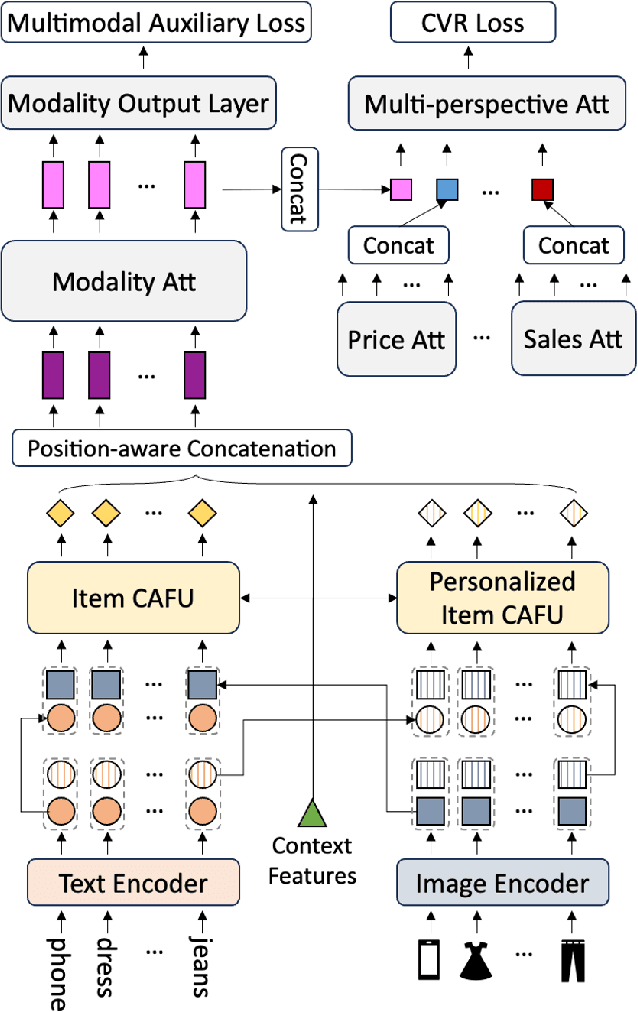
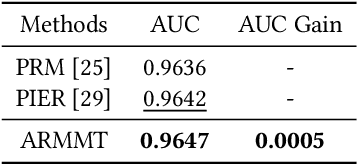

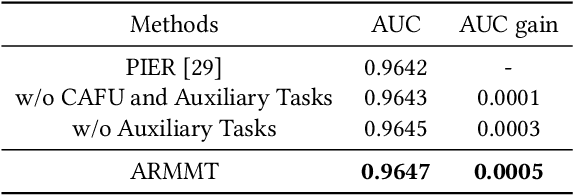
Abstract:In the rapidly evolving field of e-commerce, the effectiveness of search re-ranking models is crucial for enhancing user experience and driving conversion rates. Despite significant advancements in feature representation and model architecture, the integration of multimodal information remains underexplored. This study addresses this gap by investigating the computation and fusion of textual and visual information in the context of re-ranking. We propose \textbf{A}dvancing \textbf{R}e-Ranking with \textbf{M}ulti\textbf{m}odal Fusion and \textbf{T}arget-Oriented Auxiliary Tasks (ARMMT), which integrates an attention-based multimodal fusion technique and an auxiliary ranking-aligned task to enhance item representation and improve targeting capabilities. This method not only enriches the understanding of product attributes but also enables more precise and personalized recommendations. Experimental evaluations on JD.com's search platform demonstrate that ARMMT achieves state-of-the-art performance in multimodal information integration, evidenced by a 0.22\% increase in the Conversion Rate (CVR), significantly contributing to Gross Merchandise Volume (GMV). This pioneering approach has the potential to revolutionize e-commerce re-ranking, leading to elevated user satisfaction and business growth.
MODRL-TA:A Multi-Objective Deep Reinforcement Learning Framework for Traffic Allocation in E-Commerce Search
Jul 22, 2024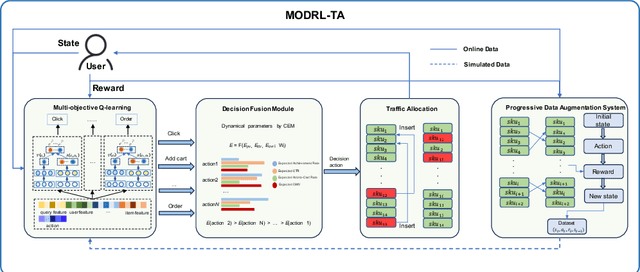

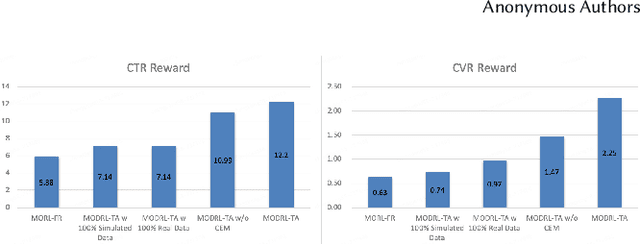

Abstract:Traffic allocation is a process of redistributing natural traffic to products by adjusting their positions in the post-search phase, aimed at effectively fostering merchant growth, precisely meeting customer demands, and ensuring the maximization of interests across various parties within e-commerce platforms. Existing methods based on learning to rank neglect the long-term value of traffic allocation, whereas approaches of reinforcement learning suffer from balancing multiple objectives and the difficulties of cold starts within realworld data environments. To address the aforementioned issues, this paper propose a multi-objective deep reinforcement learning framework consisting of multi-objective Q-learning (MOQ), a decision fusion algorithm (DFM) based on the cross-entropy method(CEM), and a progressive data augmentation system(PDA). Specifically. MOQ constructs ensemble RL models, each dedicated to an objective, such as click-through rate, conversion rate, etc. These models individually determine the position of items as actions, aiming to estimate the long-term value of multiple objectives from an individual perspective. Then we employ DFM to dynamically adjust weights among objectives to maximize long-term value, addressing temporal dynamics in objective preferences in e-commerce scenarios. Initially, PDA trained MOQ with simulated data from offline logs. As experiments progressed, it strategically integrated real user interaction data, ultimately replacing the simulated dataset to alleviate distributional shifts and the cold start problem. Experimental results on real-world online e-commerce systems demonstrate the significant improvements of MODRL-TA, and we have successfully deployed MODRL-TA on an e-commerce search platform.
A Preference-oriented Diversity Model Based on Mutual-information in Re-ranking for E-commerce Search
May 24, 2024Abstract:Re-ranking is a process of rearranging ranking list to more effectively meet user demands by accounting for the interrelationships between items. Existing methods predominantly enhance the precision of search results, often at the expense of diversity, leading to outcomes that may not fulfill the varied needs of users. Conversely, methods designed to promote diversity might compromise the precision of the results, failing to satisfy the users' requirements for accuracy. To alleviate the above problems, this paper proposes a Preference-oriented Diversity Model Based on Mutual-information (PODM-MI), which consider both accuracy and diversity in the re-ranking process. Specifically, PODM-MI adopts Multidimensional Gaussian distributions based on variational inference to capture users' diversity preferences with uncertainty. Then we maximize the mutual information between the diversity preferences of the users and the candidate items using the maximum variational inference lower bound to enhance their correlations. Subsequently, we derive a utility matrix based on the correlations, enabling the adaptive ranking of items in line with user preferences and establishing a balance between the aforementioned objectives. Experimental results on real-world online e-commerce systems demonstrate the significant improvements of PODM-MI, and we have successfully deployed PODM-MI on an e-commerce search platform.
A Unified Search and Recommendation Framework Based on Multi-Scenario Learning for Ranking in E-commerce
May 17, 2024


Abstract:Search and recommendation (S&R) are the two most important scenarios in e-commerce. The majority of users typically interact with products in S&R scenarios, indicating the need and potential for joint modeling. Traditional multi-scenario models use shared parameters to learn the similarity of multiple tasks, and task-specific parameters to learn the divergence of individual tasks. This coarse-grained modeling approach does not effectively capture the differences between S&R scenarios. Furthermore, this approach does not sufficiently exploit the information across the global label space. These issues can result in the suboptimal performance of multi-scenario models in handling both S&R scenarios. To address these issues, we propose an effective and universal framework for Unified Search and Recommendation (USR), designed with S&R Views User Interest Extractor Layer (IE) and S&R Views Feature Generator Layer (FG) to separately generate user interests and scenario-agnostic feature representations for S&R. Next, we introduce a Global Label Space Multi-Task Layer (GLMT) that uses global labels as supervised signals of auxiliary tasks and jointly models the main task and auxiliary tasks using conditional probability. Extensive experimental evaluations on real-world industrial datasets show that USR can be applied to various multi-scenario models and significantly improve their performance. Online A/B testing also indicates substantial performance gains across multiple metrics. Currently, USR has been successfully deployed in the 7Fresh App.
PPM : A Pre-trained Plug-in Model for Click-through Rate Prediction
Mar 15, 2024



Abstract:Click-through rate (CTR) prediction is a core task in recommender systems. Existing methods (IDRec for short) rely on unique identities to represent distinct users and items that have prevailed for decades. On one hand, IDRec often faces significant performance degradation on cold-start problem; on the other hand, IDRec cannot use longer training data due to constraints imposed by iteration efficiency. Most prior studies alleviate the above problems by introducing pre-trained knowledge(e.g. pre-trained user model or multi-modal embeddings). However, the explosive growth of online latency can be attributed to the huge parameters in the pre-trained model. Therefore, most of them cannot employ the unified model of end-to-end training with IDRec in industrial recommender systems, thus limiting the potential of the pre-trained model. To this end, we propose a $\textbf{P}$re-trained $\textbf{P}$lug-in CTR $\textbf{M}$odel, namely PPM. PPM employs multi-modal features as input and utilizes large-scale data for pre-training. Then, PPM is plugged in IDRec model to enhance unified model's performance and iteration efficiency. Upon incorporating IDRec model, certain intermediate results within the network are cached, with only a subset of the parameters participating in training and serving. Hence, our approach can successfully deploy an end-to-end model without causing huge latency increases. Comprehensive offline experiments and online A/B testing at JD E-commerce demonstrate the efficiency and effectiveness of PPM.
Attention Weighted Mixture of Experts with Contrastive Learning for Personalized Ranking in E-commerce
Jun 08, 2023



Abstract:Ranking model plays an essential role in e-commerce search and recommendation. An effective ranking model should give a personalized ranking list for each user according to the user preference. Existing algorithms usually extract a user representation vector from the user behavior sequence, then feed the vector into a feed-forward network (FFN) together with other features for feature interactions, and finally produce a personalized ranking score. Despite tremendous progress in the past, there is still room for improvement. Firstly, the personalized patterns of feature interactions for different users are not explicitly modeled. Secondly, most of existing algorithms have poor personalized ranking results for long-tail users with few historical behaviors due to the data sparsity. To overcome the two challenges, we propose Attention Weighted Mixture of Experts (AW-MoE) with contrastive learning for personalized ranking. Firstly, AW-MoE leverages the MoE framework to capture personalized feature interactions for different users. To model the user preference, the user behavior sequence is simultaneously fed into expert networks and the gate network. Within the gate network, one gate unit and one activation unit are designed to adaptively learn the fine-grained activation vector for experts using an attention mechanism. Secondly, a random masking strategy is applied to the user behavior sequence to simulate long-tail users, and an auxiliary contrastive loss is imposed to the output of the gate network to improve the model generalization for these users. This is validated by a higher performance gain on the long-tail user test set. Experiment results on a JD real production dataset and a public dataset demonstrate the effectiveness of AW-MoE, which significantly outperforms state-of-art methods. Notably, AW-MoE has been successfully deployed in the JD e-commerce search engine, ...
Embracing Uncertainty: Adaptive Vague Preference Policy Learning for Multi-round Conversational Recommendation
Jun 07, 2023



Abstract:Conversational recommendation systems (CRS) effectively address information asymmetry by dynamically eliciting user preferences through multi-turn interactions. Existing CRS widely assumes that users have clear preferences. Under this assumption, the agent will completely trust the user feedback and treat the accepted or rejected signals as strong indicators to filter items and reduce the candidate space, which may lead to the problem of over-filtering. However, in reality, users' preferences are often vague and volatile, with uncertainty about their desires and changing decisions during interactions. To address this issue, we introduce a novel scenario called Vague Preference Multi-round Conversational Recommendation (VPMCR), which considers users' vague and volatile preferences in CRS.VPMCR employs a soft estimation mechanism to assign a non-zero confidence score for all candidate items to be displayed, naturally avoiding the over-filtering problem. In the VPMCR setting, we introduce an solution called Adaptive Vague Preference Policy Learning (AVPPL), which consists of two main components: Uncertainty-aware Soft Estimation (USE) and Uncertainty-aware Policy Learning (UPL). USE estimates the uncertainty of users' vague feedback and captures their dynamic preferences using a choice-based preferences extraction module and a time-aware decaying strategy. UPL leverages the preference distribution estimated by USE to guide the conversation and adapt to changes in users' preferences to make recommendations or ask for attributes. Our extensive experiments demonstrate the effectiveness of our method in the VPMCR scenario, highlighting its potential for practical applications and improving the overall performance and applicability of CRS in real-world settings, particularly for users with vague or dynamic preferences.
JDsearch: A Personalized Product Search Dataset with Real Queries and Full Interactions
May 24, 2023



Abstract:Recently, personalized product search attracts great attention and many models have been proposed. To evaluate the effectiveness of these models, previous studies mainly utilize the simulated Amazon recommendation dataset, which contains automatically generated queries and excludes cold users and tail products. We argue that evaluating with such a dataset may yield unreliable results and conclusions, and deviate from real user satisfaction. To overcome these problems, in this paper, we release a personalized product search dataset comprised of real user queries and diverse user-product interaction types (clicking, adding to cart, following, and purchasing) collected from JD.com, a popular Chinese online shopping platform. More specifically, we sample about 170,000 active users on a specific date, then record all their interacted products and issued queries in one year, without removing any tail users and products. This finally results in roughly 12,000,000 products, 9,400,000 real searches, and 26,000,000 user-product interactions. We study the characteristics of this dataset from various perspectives and evaluate representative personalization models to verify its feasibility. The dataset can be publicly accessed at Github: https://github.com/rucliujn/JDsearch.
A Multi-Granularity Matching Attention Network for Query Intent Classification in E-commerce Retrieval
Mar 28, 2023



Abstract:Query intent classification, which aims at assisting customers to find desired products, has become an essential component of the e-commerce search. Existing query intent classification models either design more exquisite models to enhance the representation learning of queries or explore label-graph and multi-task to facilitate models to learn external information. However, these models cannot capture multi-granularity matching features from queries and categories, which makes them hard to mitigate the gap in the expression between informal queries and categories. This paper proposes a Multi-granularity Matching Attention Network (MMAN), which contains three modules: a self-matching module, a char-level matching module, and a semantic-level matching module to comprehensively extract features from the query and a query-category interaction matrix. In this way, the model can eliminate the difference in expression between queries and categories for query intent classification. We conduct extensive offline and online A/B experiments, and the results show that the MMAN significantly outperforms the strong baselines, which shows the superiority and effectiveness of MMAN. MMAN has been deployed in production and brings great commercial value for our company.
 Add to Chrome
Add to Chrome Add to Firefox
Add to Firefox Add to Edge
Add to Edge